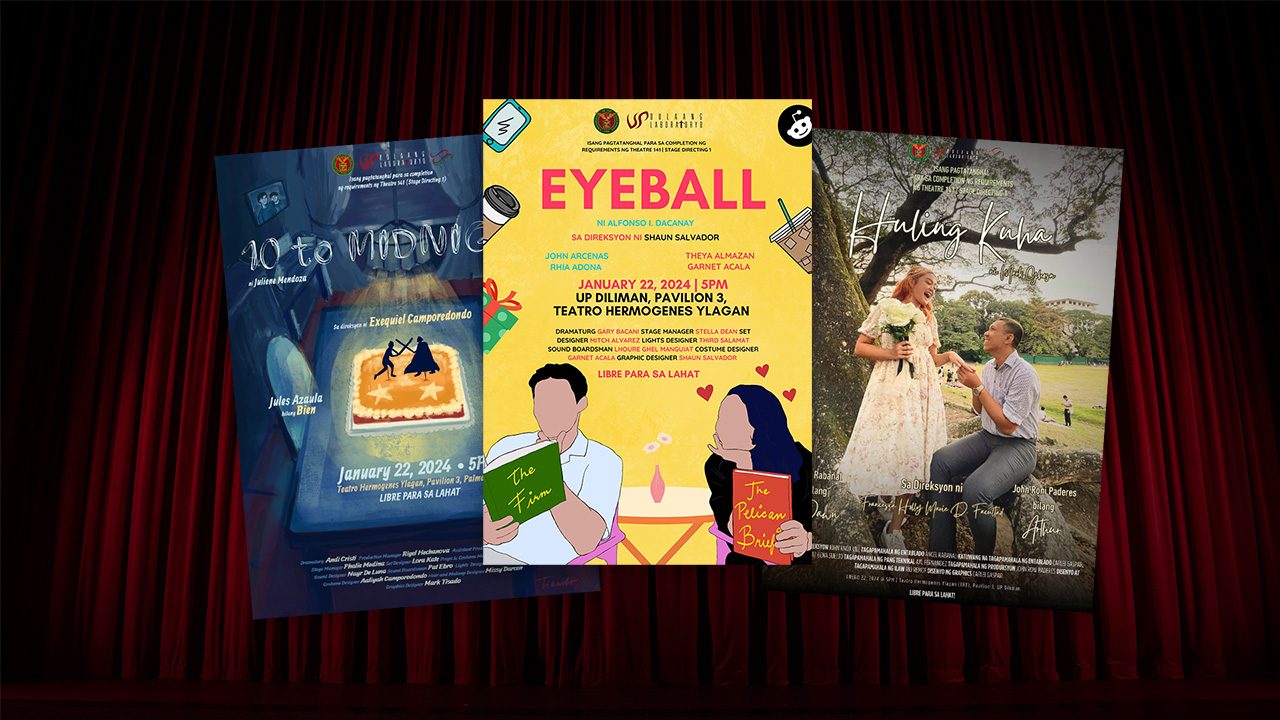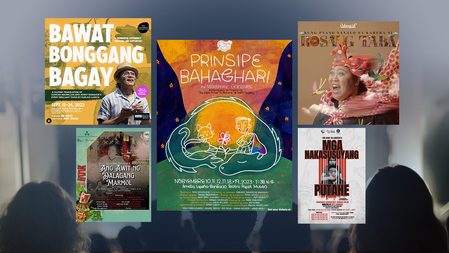SUMMARY
This is AI generated summarization, which may have errors. For context, always refer to the full article.

The latest adaptations staged by UP Dulaang Laboratoryo behave in ways that pull audience members in many directions, pleasant or otherwise. For any material to work, it is imperative for directors to understand that their vision must meet, if not expand on, the source beyond intentions to distinguish what it offers from its predecessor. Incubation, too, is a chief aspect, precisely because one cannot expect refined insights from hasty attempts at it. One must give it time and actual effort.
All honed under stage directing classes, the three plays in the roster are gently warm and silly on the surface. All of which, at its core, negotiate with relationships at different junctures in our lives: one at an early stage, another set to begin a new track, and another hoping to mend what was once a strong connection. But what defines, if not separates, this triptych from one another is depth and each material’s decision to interrogate prescient discussions head-on or evade it altogether.
Here is a closer look at each staging.
Eyeball (written by Alfonso Dacanay, directed by Shaun Salvador)

When Eyeball leans into the right impulse, it can easily pull off its comedy. It’s all a matter of timing, as one might venture to point out, which figures in the work of Garnet Acala as Wilson, best friend of chief character Eileen (Theya Almazan), who steps out of her shell and agrees to meet Patrick (John Arcenas) at a cafe, buoyed only by their four-month encounter online and their penchant for anything John Grisham.
Acala steals the show because of how they make the most out of what is given to them, even at times when playwright Alfonso Dacanay retreats to humor when the plotting begins to feel aimless, if not one-note. The emotional heft doesn’t quite come through because the script operates from a vantage point that refuses to really let us into the excitement, delusions, and dangers of virtual dating and what comes after it. The intrigue is there, but the show falters to make it more tempting.
For the most part, Eyeball ticks the boxes yet fails to excavate a wealth of insight beyond that. Consider how it is immediately out in the open that Patrick’s a jerk, only for the material to affirm the obvious in its endnote. It’s a barrel of laughs, there’s no doubt about that, but the comic relief can only do so much. It’s among those works that I wish had the gall to risk something more, to not shy away from sheer audacity. Nevertheless, we take what we can get and applaud the effort.
Huling Kuha (written by Mark Ghosn, directed by Francesca Holly Marie Facultad)

What hinders Huling Kuha from completely reaching a satisfying peak is that it rushes itself to head to the next plot point. Things escalate so quickly and in ways that it doesn’t afford one to let the feeling linger, to relish the moment that could have greatly illuminated its central narrative, about a couple set to enter married life, until one cheats on the other yet again. And when it comes to adapting a work on the stage, pacing, no matter the flaws of the source material, is one thing that can be addressed through directing, a glaring lapse that is simply difficult to set aside, considering how the show hinges so much on building tension. And if its idea of tension is steeping its characters in loud, grating exchanges to tedious extent, then it clearly misses the point. The result is this floodgate of emotions that doesn’t feel quite as sweeping as it intends to. But one can admire the earnestness propelling the duo of Ancel Rabanal and John Roni Paderes, despite the excess, especially at a point when the audience erupts into raucous laughter amid a heated and critical moment between the characters. Huling Kuha would have been far more emotionally full had it only let its narrative breathe, had it not taken itself too seriously.
10 to Midnight (written by Juliene Mendoza, directed by Exequiel Camporedondo)

Among the plays in the roster, I am most familiar with 10 to Midnight, Juliene Mendoza’s entry to last year’s Virgin Labfest, which I chiefly recall for how the playwright treats the story with sheer heart and throbbing tenderness. Of course, it’s hard to tame expectations, given how compact and reliable the material is. Yet, from the terrific poster by Mark Tisado to the impressive execution by director Exequiel Camporedondo, there is never a false note in this adaptation. Never did I try to measure the work based on its predecessor, even when I was tempted to, for it is so comfortable in its own skin that it feels like a new work altogether.
Camporedondo knows what he’s doing. He knows that he can still drill into the heart even when he subtly tweaks the ending. He knows how to make us burst into laughter, how to keep the looming ache at bay, and when to pull the trigger and let go. So does the tandem of Jules Azaula and Jigger Sementilla as Bien and Billy, respectively, brothers whose relationship has gone sour after their father’s demise. Their characters are exact opposites, but Azaula and Sementilla make the perfect pair, for how they can individually command their parts, be playful, and still be completely attuned to each other’s emotional beats and the narrative’s rhythm. There is so much restraint in the work but it’s not tight; it is calculated but effortless. Lora Kate and Reign Fausto also did incredibly well in the set design and props and costume department to heighten the distance between Bien and Billy, and how debilitating their relationship can be, just as lights designer Third Salamat finds the right opportunity to allow the heaviness to sink in, to make the heft more volcanic.
10 to Midnight excavates many things: familial baggage, mental health issues, toxic masculinity, substance abuse, and plenty more. But what it achieves with such force is how to structure each matter it untangles in perfect alignment and how to take its time to see the whole from afar, like looking at a constellation so vivid and fascinating. First great piece of theater I’ve seen this year. – Rappler.com
Add a comment
How does this make you feel?

There are no comments yet. Add your comment to start the conversation.